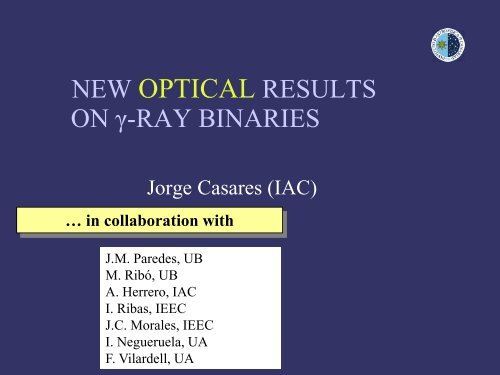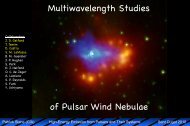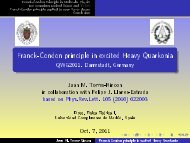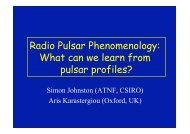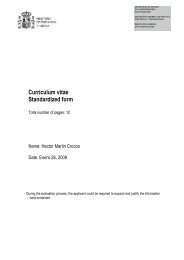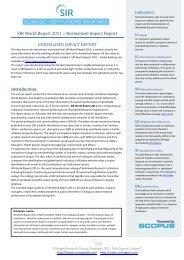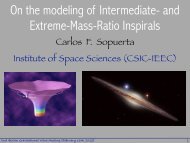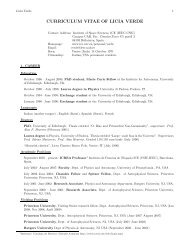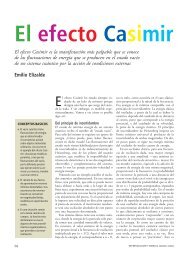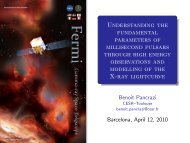Create successful ePaper yourself
Turn your PDF publications into a flip-book with our unique Google optimized e-Paper software.
NEW OPTICAL RESULTSON γ-RAY BINARIESJorge Casares (IAC)… in collaboration withJ.M. Paredes, UBM. Ribó, UBA. Herrero, IACI. Ribas, IEECJ.C. Morales, IEECI. Negueruela, UAF. Vilardell, UA
Outline1.- Introduction: γ-Ray Binaries2.- Revised Orbital Solution in LS 50393.- Probing Binarity in MWC 148 (=HESS J0632+057)4.- Conclusions
1.- Introduction• Only 3 galactic HMXBs clearly detected at TeV (PSRB1259-63, LS 5039 & LSI +61 303), plus 1 candidate(HESS J0632+057).• VHE modulated with orbital period emitter closeto massive star• Origin of VHE emission unclear: leptonic/hadronicscenarios invoking IC/pp collisions in jet/pulsar wind• Nature of compact star important in γ-ray productionmodels. PSR B1259-63 holds a NS but a BH is nottotally ruled out in LS 5039 & LSI +61 303dynamical studies are required.
2.- Revised orbital solution in LS 5039• First γ-ray Binary detected by HESS at TeV with L γ =10 34 ergs/s• Spatially resolved radio emissionMicroquasar or pulsar wind?• Radial velocity curve of the 06.5V((f)) indicate P orb =3.906 d (Casares et al.2005). But the orbital parameters depend on the spectral lines used.HI and HeI may be contaminated by wind emissionbecause show larger scatter and the solution is blueshiftted(as expected by contamination from P-Cygni)We adopted the HeII solution
Optical star almost fills Roche lobe at periastronpseudo-synchronized1/ 2(1 e)1V sin i 2Rc Porbsin3/ 2(1 e)V sin i=113 km/sii = 23.2 -- 26.8 oThis result suggests that LS 5039 might be a black hole with 3-5 solar masses
New Spectroscopy of LS 5039● 202 INT spectra from 2002-2003Δ 28 SAAO spectra from 2005○ 122 INT spectra from 2007 & 2009Evidence for a 1d (=1/4 P orb ) oscillation stable over 7 years
Not accounting for 1d perturbation understimates e, K 1 and hence f(M)Parameter A09 (All lines) C05 (HeII) SZ10 (HeII)P orb (days) 3.9061(1) 3.9060(2) 3.906 (fixed)To 2825.99(5) 1943.1(1) 5017.08(6)e 0.34(4) 0.35(4) 0.24(8)ω ( ○ ) 236.0(6) 226(3) 237(22)γ (km/s) 4.0(3) 17.2(7) 4(1)K 1 (km/s) 19.7(9) 25(1) 24(4)a 1 sin i (R ) 1.44(7) 1.8(1) 1.8(2)f(M) (M ) 0.0026(4) 0.0053(9) 0.0049(6)rms (km/s) 7.1 9.1 6.2A09: Aragona et al 2009C05: Casares et al. 2005SZ10: Szalai et al. 2010C10 (HeII) C10*C10: with 1d oscillationC10* : after subtracting 1d oscillation3.90597(9) 3.90608(8)2478.11(8) 2478.08(6)0.30(3) 0.35(3)215(6) 212(5)17.3(5) 17.3(5)23.1(9) 24.2(9)1.70(7) 1.75(7)0.0043(5) 0.0047(6)8.3 6.4Possibly due to non-radial oscillations, similar to Vela X-1, where 5km/s amplitude oscillations at ¼ Porb (i.e. 2.2d) are also detected(Quaintrell et al. 2003 A&A 401 313)It may also have an impact in VHE production because of the roleof stellar photons in IC scattering
3.- Probing binarity in MWC 148Optical counterpart of point-like TeV source HESS J0632+057Proposed as new γ-ray binary because of variable radio and X-rayemission with similar spectral properties as other 3 γ-ray binariesOptical campaign to search for repeatible variability1) INT/WHT Oct/Dec 2008 at ~100 km/s res.2) Mercator Nov 2009 at 7 km/s res.3) Stella Jan-Apr 2010 ,, ,,B0pe star with broad HeIabsorption lines (v sin i=370 km/s)Typically v sini ~ 0.7-0.8 v crit andv crit ~565 km/s for B0V so i~55-70 ○Absorption lines show radial velocity variations with a few 10 km/samplitude but no clear periodicity
Long-term variability in Hα lineWHT 2008Mercator 2009Stella 2010If orbital would imply P orb > 200 days
Conclusions●●●We have detected ~1 day (0.25 P orb ) radial velocityoscillations in the companion star of LS 5039. Likelycaused by non-radial stellar oscillations. Must beaccounted for when deriving orbital parameters.We see radial velocity excursions in MWC 148 withamplitude a few tens km/s but no clear periodicity.Long-term variations in H α & H β parameters (EWs,FWHM, Centroid) with time-scale of >200 days.Orbital period or circumstellar disc cycles?


